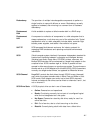B-8 Glossary
Copyright © 2002 by LSI Logic Corporation. All rights reserved.
Service
Provider
The Service Provider (SP) is a program that resides in the desktop
system or server and is responsible for all DMI activities. This layer
collects management information from products (whether system
hardware, peripherals, or software), stores that information in the DMI
database, and passes it to management applications as requested.
SNMP Simple Network Management Protocol. The most widely used protocol
for communicating management information between the managed
elements of a network and a network manager. SNMP focuses primarily
on the network backbone. The Internet standard protocol that manages
nodes on an Internet Protocol (IP) network.
Spanning Array spanning by a logical drive combines storage space in two arrays
of disk drives into a single, contiguous storage space in a logical drive.
MegaRAID logical drives can span consecutively numbered arrays that
each consist of the same number of disk drives. Array spanning
promotes RAID levels 1 and 5 to RAID levels 10 and 50, respectively.
See also Disk Spanning.
Spare A disk drive available to back up the data of other drives.
Stripe Size The amount of data contiguously written to each disk. You can specify
stripe sizes of 4, 8, 16, 32, 64, and 128 Kbytes for each logical drive. For
best performance, choose a stripe size equal to or smaller than the block
size used by the host computer.
Stripe Width The number of disk drives across which the data is striped.
Striping Segmentation of logically sequential data, such as a single file, so that
segments can be written to multiple physical devices in a round-robin
fashion. This technique is useful if the processor can read or write data
faster than a single disk can supply or accept it. While data is being
transferred from the first disk, the second disk can locate the next
segment. Data striping is used in some modern databases and in certain
RAID devices.
Terminator A resistor connected to a signal wire in a bus or network for impedance
matching to prevent reflections—for example, a 50 ohm resistor
connected across the end of an Ethernet cable. SCSI buses and some
LocalTalk wiring schemes also require terminators.


















